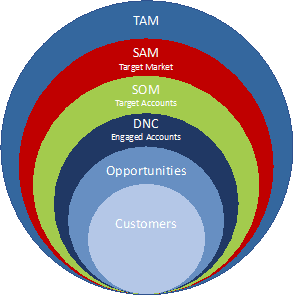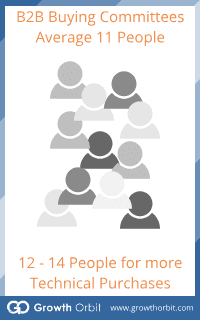Why sales development programs fail. #2 Bad prospecting data.
Growth Orbit Insights
In the first part of this series on why sales development programs fail, we discussed the need for you and your team to be fully committed to the success of your lead generation programs. Having a dedicated, hard-working group of employees rallying around a cause is great. However, long-term, meaningful success depends on several other factors as well.
In this second part of the series we will introduce ways to avoid sales development program failure by minimizing the chances of having bad data for your team to work with.
Generally speaking, all contact lists are bad. In fact, most of them are downright terrible. No matter how you source your contact data, there are ways to ensure that your program’s efforts are focused on the most appropriate audience.
by Steve Schilling
Define the market for more accurate targeting
Successful sales development hinges on the ability to define the addressable market. Understanding the market’s demand for your product or service lets you set realistic sales goals. A deep dive into TAM (Total Addressable Market), SAM (Serviceable Available Market), and SOM (Serviceable Obtainable Market) provides the road map for sales development success.
 B2B companies that short cut on this work are setting themselves up for their sales development programs to fail. Random prospecting lists of contacts—compilations of trade show attendees, people who’ve downloaded marketing materials, names purchased from list brokers, and contacts that have been loaded into the CRM over the years—isn’t going to deliver what you’re looking for in a sales development program.
B2B companies that short cut on this work are setting themselves up for their sales development programs to fail. Random prospecting lists of contacts—compilations of trade show attendees, people who’ve downloaded marketing materials, names purchased from list brokers, and contacts that have been loaded into the CRM over the years—isn’t going to deliver what you’re looking for in a sales development program.
Lists put together this way are rarely compiled with thought, strategy, understanding, or alignment with the company’s Ideal Customer Profile (ICP). They’re just names and numbers to call—and a not-very-efficient way to generate qualified leads.
When this kind of market data is used as the foundation of a lead generation program, the program is likely to fail. Why?
- Bad market data means a high number of targets fall out as unqualified. The sales development team will put in significant effort to engage these targets. Working through poor quality data issues, conducting research, and cleaning up contact info as they go costs time and money—and delivers disappointing results. The need to do this tedious work is distracting and unmotivating to sales development professionals. Starting out with a bad list means you end up with low lead production, frustrating both the front-line team, the sales force and leadership.
- A lead generation program focused on unproductive targets ends up with misleading results. Measurements and lead expectations quickly fall short, and a program that may have been strong is declared a bust. To catch fish, you must first fish in a pond that contains fish. If the market you are calling on isn’t a fit, you won’t get the outcomes you’re looking for.
A common scenario with internal lead development efforts is the company doesn’t provide quality prospect list to their team and expects them to develop their own targets. “After all, that’s what we are paying them for” is the thought process. These professionals were hired for their expertise in engaging prospects on the phone. Asking them to do administrative work is not in keeping with their best and highest use.
Finding viable targets, even with modern day tools such as Discover.org or LinkedIn Navigator, still takes time. Add to that CRM searches to ensure they are untouched and appropriate research to customize the selling approach, and the result is countless hours are wasted that could otherwise be used for calling.
The targeting challenge
Forrester finds that 35% of marketers cite inaccurate targeting as their greatest hurdle to favorable marketing outcomes. Targeting errors compound into weeks and months of lost time spent chasing companies that are never going to buy. These costly, time-consuming, wasted efforts are why sales development programs fail.
TAM determination needs to be specific and detailed. While most B2B buying decisions today are complex and involve multiple parties, targeting all potential contacts at any given prospect company is too costly and time consuming to be practical. Success calls for hyper-targeted lists made up of only qualified prospects.
For most B2B transactions, there are a limited number of ultimate decision makers and influencers. These are the targets that need to be identified and engaged as quickly as possible. Loading up a sales development effort with 10, 20 or more contacts for the same organization is a formula guaranteed to waste time—and lead to failure. Finding and developing a hyper-targeted list (the low-hanging fruit) is an efficient use of time and effort in the early, high velocity stage (lead development) of the sales cycle.
Single Decision Maker vs Buying Committee
 Unless you’re selling to small business, chances are your prospective customer’s purchase decisions route through some form of committee. When targeting these organizations, the first challenge is to get the attention of one or more potential individuals overseeing the area your product addresses and position your solution to uniquely solve a problem they’re dealing with.
Unless you’re selling to small business, chances are your prospective customer’s purchase decisions route through some form of committee. When targeting these organizations, the first challenge is to get the attention of one or more potential individuals overseeing the area your product addresses and position your solution to uniquely solve a problem they’re dealing with.
The most effective way to do this is to provide some form of valuable insight to a committee member that arms them with knowledge and makes them an advocate for your solution. While these selling situations create the potential for to identify multiple valid targets in any given organization, unless the goal of the program is to implement an ABM (Account Based Marketing) strategy, the lead generation effort should only focus on the two or three most likely targets. The goal of the lead generation effort is to identify a valid decision maker or key influencer, engage the target, deliver insight and spark awareness of a problem that your solution can uniquely solve and begin the selling process.
By definition, an effort that is attempting to engage all or most potential members of a buying committee is an ABM initiative, not a lead generation program and should be scoped and managed accordingly.
The more specific the better
Another cause for sales development programs to fail is vaguely defined ideal prospect profiles. When developing a target prospect list it’s good to get specific.
For example, “professional services companies over $100 million in annual revenue” is a good starting point, but, that alone won’t generate the list of actionable companies your team needs to market to.
Target market list development requires moving to progressively more granular levels to identify:
- How many companies fit that profile.
- What companies they are.
- Which titles within those companies are likely decision makers.
- How many people with those titles there are.
- Which people they are.
Your goal is to create a list of prospective customers with the appropriate contacts within the targeted companies.
 Creating a list of targets in your market is a balancing act. A consensus in the sales development business is that there is no such thing as a good list. With that understood, keep in mind that the quality of list sources varies greatly.
Creating a list of targets in your market is a balancing act. A consensus in the sales development business is that there is no such thing as a good list. With that understood, keep in mind that the quality of list sources varies greatly.
List providers such as Discover.org or Dun and Bradstreet offer reasonable quality target data for most larger businesses.
Alternatively, for some targets such as retailers or healthcare providers, more specialized list sources may offer better alternatives.
And for highly specialized targeting, i.e., “… companies in excess of $1 billion in revenue that run SAP Financials …” custom list development projects may be required to get the quality targets you need.
There are ultimately an infinite number of options to choose from when working to procure or create target prospect lists, but keep in mind that you typically get what you pay for.
Part 2 of 4
This is the second of a four-part blog series covering the top reasons lead development programs fail. The blog series is excerpted from Growth Orbit’s new eBook: 4 Reasons Why Sales Development Programs Fail (And What You Can Do About It).
About Growth Orbit
Growth Orbit is a full-service growth acceleration firm, focused on driving measurable value through growth initiatives that work. We excel at combining sound growth strategy with proven sales methodologies, supported by effective technology. We only consider ourselves successful when we deliver accelerated, measurable growth for our clients.
From developing smart insight driven sales messaging, to filling your funnel with qualified leads, we’ve built our foundation on meeting clients where they are and helping them achieve new levels of growth — what we call reaching Growth Orbit!




